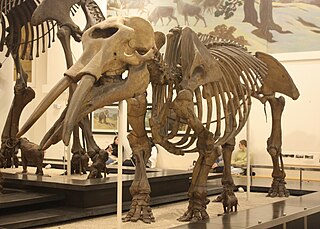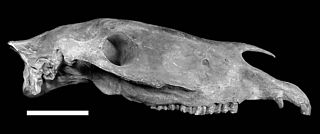
Proboscidea is a taxonomic order of afrotherian mammals containing one living family (Elephantidae) and several extinct families. First described by J. Illiger in 1811, it encompasses the elephants and their close relatives. Three species of elephant are currently recognised: the African bush elephant, the African forest elephant, and the Asian elephant.

Mammutidae is an extinct family of proboscideans belonging to Elephantimorpha. It is best known for the mastodons, which inhabited North America from the Late Miocene until their extinction at beginning of the Holocene, around 11,000 years ago. The earliest fossils of the group are known from the Late Oligocene of Africa, around 24 million years ago, and fossils of the group have also been found across Eurasia. The name "mastodon" derives from Greek, μαστός "nipple" and ὀδούς "tooth", referring to their characteristic teeth.

Gomphotheres are an extinct group of proboscideans related to modern elephants. First appearing in Africa during the Oligocene, they dispersed into Eurasia and North America during the Miocene and arrived in South America during the Pleistocene as part of the Great American Interchange. Gomphotheres are a paraphyletic group ancestral to Elephantidae, which contains modern elephants, as well as Stegodontidae.

Macrauchenia is an extinct genus of large ungulate native to South America from the Pliocene or Middle Pleistocene to the end of the Late Pleistocene. It is a member of the extinct order Litopterna, a group of South American native ungulates distinct from the two orders which contain all living ungulates which had been present in South America since the early Cenozoic, over 60 million years ago, prior to the arrival of living ungulates in South America around 2.5 million years ago as part of the Great American Interchange. The bodyform of Macrauchenia has been described as similar to a camel, being one of the largest-known litopterns, with an estimated body mass of around 1 tonne. The genus gives its name to its family, Macraucheniidae, which like Macrauchenia typically had long necks and three-toed feet, as well as a retracted nasal region, which in Macrauchenia manifests as the nasal opening being on the top of the skull between the eye sockets. This has historically been argued to correspond to the presence of a tapir-like proboscis, though recent authors suggest a moose-like prehensile lip or a saiga antelope-like nose to filter dust are more likely.

Cuvieronius is an extinct New World genus of gomphothere which ranged from southern North America to western South America during the Pleistocene epoch. Among the last gomphotheres, it became extinct at the end of the Pleistocene, approximately 12,000 years ago, following the arrival of humans to the Americas.

Stegomastodon is an extinct genus of gomphotheres. It ranged throughout North America from the Pliocene, to the Early Pleistocene. The former South American species have been synonymized with Notiomastodon platensis.

Xenorhinotherium is an extinct genus of macraucheniine macraucheniids, native to northern South America during the Pleistocene epoch, closely related to Macrauchenia of Patagonia. The type species is X. bahiense.

Sinomastodon is an extinct gomphothere genus known from the Late Miocene to Early Pleistocene of Asia, including China, Japan, Thailand, Myanmar, Indonesia and probably Kashmir.

Hippidion is an extinct genus of equine that lived in South America from the Late Pliocene to the end of the Late Pleistocene (Lujanian), between 2.5 million and 11,000 years ago. They were one of two lineages of equines native to South America during the Pleistocene epoch, alongside Equus (Amerhippus) neogeus.

Eubelodon is an extinct genus of gomphothere which lived in North America during the Miocene Epoch. It contains a single species: Eubelodon morrilli.

Zygolophodon is an extinct genus of mammutid proboscidean that lived during the Miocene in Africa, Eurasia, and North America.

Notiomastodon is an extinct genus of gomphothere proboscidean, endemic to South America from the Pleistocene to the beginning of the Holocene. Notiomastodon specimens reached a size similar to that of the modern Asian elephant, with a body mass of 3-4 tonnes. Like other brevirostrine gomphotheres such as Cuvieronius and Stegomastodon, Notiomastodon had a shortened lower jaw and lacked lower tusks, unlike more primitive gomphotheres like Gomphotherium.

Arctotherium is an extinct genus of the Pleistocene short-faced bears endemic to Central and South America. Arctotherium migrated from North America to South America during the Great American Interchange, following the formation of the Isthmus of Panama during the late Pliocene. The genus consists of one early giant form, A. angustidens, and several succeeding smaller species, which were within the size range of modern bears. Arctotherium was adapted to open and mixed habitat. They are genetically closer to the spectacled bear, than to Arctodus of North America, implying the two extinct forms evolved large size in a convergent manner.

Equus neogeus is an extinct species of equine native to South America during the Pleistocene. It was formerly thought to be several distinct species within the subgenus Amerhippus, but was later shown to be a single morphologically variable species. It is thought to be closely related to true horses.
Surameryx is an extinct genus of herbivorous artiodactyls originally described as belonging to the extinct family Palaeomerycidae. A single species, S. acrensis, was described from the Late Miocene of the Madre de Dios Formation, South America. It was originally interpreted as one of the few northern mammals that entered South America before the Pliocene. However, both its identification as a member of the family Palaeomerycidae and claims about its Miocene age were subsequently challenged.

Equus stenonis is an extinct species of equine that lived in Western Eurasia during the Early Pleistocene epoch.

Eozygodon is an extinct genus of proboscidean in the family Mammutidae that is based on a single species, E. morotoensis, named in 1983. It is known from the Early Miocene of Africa and well as possibly the Middle Miocene of China. It is considered a primitive member of the family, retaining a long lower jaw (longirostrine) with lower tusks. The upper tusks are small, and are parallel to each other. The skull of the young adult AM 02 from Auchas, Namibia, was around the size of that of a 10 year old American mastodon, around 60 centimetres (2.0 ft) in maximum length. Dental mesowear from East African specimens suggests a browsing diet. Some authors suggest that Eozygodon could be less closely related to other members of Mammutidae than other mammutids are to Elephantida, making Mammutidae as typically defined paraphyletic.
Agalmaceros is a potentially invalid extinct genus of deer of the Cervidae family, that lived in South America during the Pleistocene. The only species currently known is A. blicki. Remains have only been found in Ecuador. It showed a clear affinity to Andean or temperate habitats. Agalmaceros blicki is estimated to have been 60 kilograms (130 lb) in weight.

The Sabana Formation is a geological formation of the Bogotá savanna, Altiplano Cundiboyacense, Eastern Ranges of the Colombian Andes. The formation consists mainly of shales with at the edges of the Bogotá savanna lignites and sandstones. The Sabana Formation dates to the Quaternary period; Middle to Late Pleistocene epoch, and has a maximum thickness of 320 metres (1,050 ft), varying greatly across the savanna. It is the uppermost formation of the lacustrine and fluvio-glacial sediments of paleolake Humboldt, that existed at the edge of the Eastern Hills until the latest Pleistocene.

















